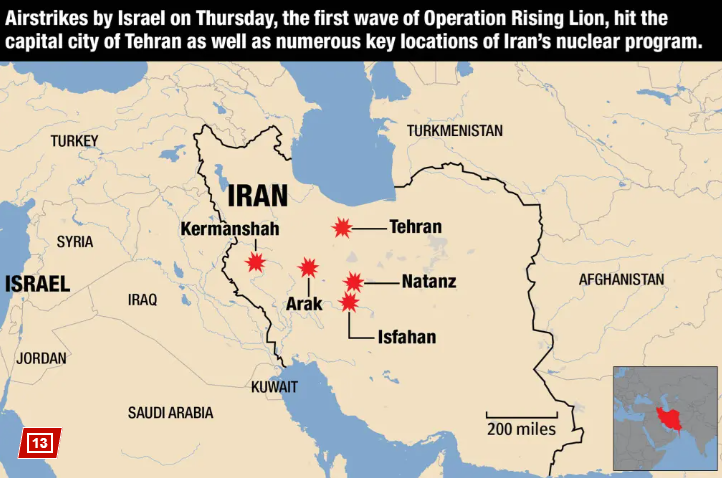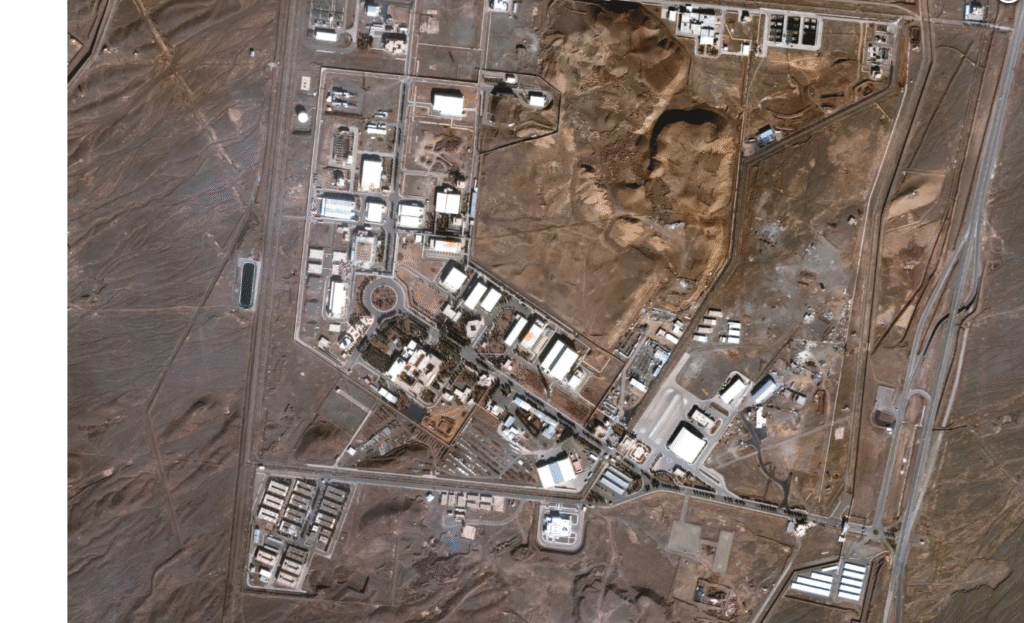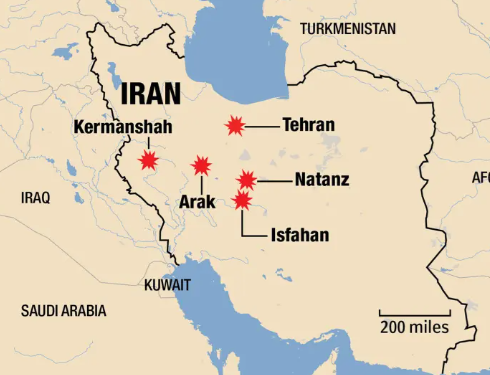TEL AVIV / TEHRAN – Israel initiated extensive airstrikes against targets in Iran, stating the action was necessary to address Iran’s nuclear program. Iran responded on Friday by deploying 100 drones and characterized the Israeli actions as a “declaration of war.”
The strikes reportedly targeted nuclear facilities and missile factories in the Iranian capital. Reports indicate a number of military commanders were killed in the attacks, which some analysts describe as one of the most substantial actions Iran has experienced since its conflict with Iraq in the 1980s.

Israeli Prime Minister Benjamin Netanyahu stated that “Operation Rising Lion” aimed at dismantling Iran’s nuclear infrastructure, ballistic missile factories, and military facilities. He described this as an effort to counter what Israel views as a threat to its existence. In an address, Netanyahu stated, “We cannot leave these threats for the next generation,” and indicated the attacks would continue “as many days as it takes.” He further elaborated, “Because if we don’t act now, there will not be another generation. If we don’t act now, we simply won’t be here. We have internalized the lessons of history. When an enemy says he intends to destroy you — believe him.”
Responses from Iran and the United States
Iran’s Supreme Leader Ayatollah Ali Khamenei warned of “severe punishment,” and Iran described the strikes as a “declaration of war.”
President Donald Trump, in a Truth Social post, attributed Israel’s actions to Iran’s alleged failure to reach a nuclear deal. Trump stated, “I gave Iran chance after chance to make a deal. I told them, in the strongest of words, to ‘just do it,’ but no matter how hard they tried, no matter how close they got, they just couldn’t get it done.” He also commented on the reported fatalities among Iranian officials, adding, “They are all DEAD now, and it will only get worse!” Trump urged Iran to “make a deal, before there is nothing left, and save what was once known as the Iranian Empire. No more death, no more destruction, JUST DO IT, BEFORE IT IS TOO LATE.”
According to a source who spoke to The Post, the strikes followed a recent report indicating that Iran had enriched uranium to a level sufficient for nuclear bomb production within days.
Military Operations and Retaliation
The Israeli military reported that approximately 200 aircraft participated in the initial attacks on around 100 targets. These targets included Iran’s primary nuclear enrichment facility in Natanz, where smoke was observed emanating from the building. Later reports from Israel indicated the destruction of numerous radar installations and surface-to-air missile launchers in western Iran.

Two security officials stated that Israel’s Mossad intelligence agency had deployed explosive drones within Iran prior to the attack, which were then activated to target missile launchers near Tehran. They further claimed that Israel had introduced precision weapons and vehicle-mounted strike systems into central Iran, which were activated to engage Iranian air defenses as the operation commenced.
In retaliation, Iran launched over 100 drones towards Israel. Israel stated these drones were being intercepted outside its airspace, though the effectiveness of these interceptions was not immediately confirmed.
International Commentary and Security Measures
In a letter to the United Nations, Iran’s Foreign Minister Abbas Araghchi termed the attack a “declaration of war” and requested the Security Council to address the issue.
Experts described the geographic range of Israel’s strikes as extensive. Michael Doran, a former Pentagon official and Middle East scholar, commented on X, stating, “Israel’s campaign against Iran is another one for the history books. As in the opening of the Six-Day War — when Israel crippled three Arab air forces in a matter of hours — Israel has struck first, deep, and hard. It hit targets across Iran, a huge country, with precision and total surprise.” He added, “The scale and reach of the operation are staggering… This was more than a military action. It was a demonstration of intelligence dominance and operational mastery.”
The Trump administration, which had reportedly advised Israel against such an attack during ongoing negotiations on Iran’s nuclear enrichment, stated it was not involved in the strikes. Secretary of State Marco Rubio affirmed, “We are not involved in strikes against Iran, and our top priority is protecting American forces in the region.” Rubio added, “Israel advised us that they believe this action was necessary for its self-defense. President Trump and the Administration have taken all necessary steps to protect our forces and remain in close contact with our regional partners. Let me be clear: Iran should not target US interests or personnel.”
A source indicated that the U.S. might be compelled to intervene to protect Israel and to prevent Israel from deploying its nuclear weapons. Following these developments, the U.S. Embassy in Israel issued a directive for all U.S. government employees and their family members to shelter in place.
Israeli Military Statements
Lt. Gen. Eyal Zamir, chief of staff of the Israel Defense Forces, stated that Israel had reached a “point of no return.” In remarks published by the IDF, he said, “We cannot wait for another time to act, we have no choice.” He also stated, “History, both distant and recent, has taught us that in the face of ambitions to destroy us, we must not bow our heads, and so we fight to preserve our existence. Freedom is granted to those who are willing to fight for it.”
Earlier on Thursday, Mr. Trump had indicated that an Israeli airstrike “looks like it’s something that could very well happen” but did not confirm the operation was “imminent.” Israeli Ambassador to the United Nations Danny Danon urged the Security Council to support Israel, stating, “This is a moment to make moral decisions. Stand by Israel or you will be partners in a dangerous silence.”
Article Lesson
Part 1: Key Vocabulary and Definitions
Understanding the core vocabulary is crucial for comprehending the article. Read through the words and their definitions below, then try to find them in the text.
- Airstrikes (n.): Military attacks in which aircraft drop bombs or fire missiles at a target on the ground.
- Example from text: “Israel launches airstrikes on Iran’s nuclear program…”
- Nuclear program (n.): A country’s plan or initiative related to developing nuclear weapons or nuclear energy.
- Example from text: “…destroy Tehran’s nuclear program…”
- Top military officials (n. phrase): High-ranking leaders or commanders in a country’s armed forces.
- Example from text: “…killing top military officials…”
- Large-scale (adj.): Involving many people or things, or happening over a wide area.
- Example from text: “Israel launched large-scale airstrikes against Iran…”
- Dismantle (v.): To take apart a machine or structure so that it is in separate pieces; to break up or destroy something gradually.
- Example from text: “…a bid to dismantle the country’s nuclear infrastructure…”
- Ballistic missile (n.): A missile that is guided for only part of its flight.
- Example from text: “…ballistic missile factories…”
- Roll back (phrasal verb): To reduce the power or importance of something; to reverse a trend.
- Example from text: “…an effort to ‘roll back‘ Iran’s threat…”
- Barrage (n.): A concentrated artillery bombardment over a wide area; a rapid, large-scale outpouring of something.
- Example from text: “Iran quickly called the barrage of strikes a ‘declaration of war’…”
- Enriched uranium (n. phrase): Uranium that has been processed to increase the concentration of the isotope uranium-235, which is necessary for nuclear weapons and power.
- Example from text: “…Iran had enriched enough uranium to build nuclear bombs…”
- Billowing (v. – present participle): (of smoke, cloud, or steam) moving or flowing outwards with a swelling motion.
- Example from text: “…black smoke was seen billowing from the building.”
- Radar installations (n. phrase): Equipment used to detect the presence, direction, distance, and speed of aircraft, ships, and other objects, by sending out pulses of radio waves which are reflected off the object back to the source.
- Example from text: “…destroyed dozens of radar installations…”
- Surface-to-air missile launchers (n. phrase): Military equipment designed to fire missiles from the ground at aircraft.
- Example from text: “…and surface-to-air missile launchers in western Iran.”
- Mossad (n.): The national intelligence agency of Israel.
- Example from text: “…the country’s Mossad spy agency…”
- Smuggled (v. – past participle): Moved (goods) illegally and secretly into or out of a country.
- Example from text: “…Israel had also smuggled precision weapons into central Iran…”
- Intercepted (v. – past participle): Prevented (someone or something) from reaching their intended destination.
- Example from text: “…the drones were being intercepted outside its airspace…”
- Staggering (adj.): Deeply shocking; astonishing.
- Example from text: “The geographic range of Israel’s strikes was ‘staggering‘…”
- Crippled (v. – past tense): Caused (someone or something) to become unable to move or function properly.
- Example from text: “…when Israel crippled three Arab air forces…”
- Operational mastery (n. phrase): Extreme skill or proficiency in carrying out military or strategic actions.
- Example from text: “…It was a demonstration of intelligence dominance and operational mastery…”
- Retaliation (n.): The action of returning an attack, an injury, etc., with a similar one.
- Example from text: “…warned against any retaliation targeting US interests or personnel.”
- Shelter in place (phrasal verb): To stay in one’s current location, usually indoors, during an emergency or dangerous situation.
- Example from text: “…directed all US government employees and their family members to shelter in place…”
- Point of no return (n. phrase): The stage in a process at which a decision or action cannot be reversed.
- Example from text: “…had reached a ‘point of no return‘.”
- Bow our heads (idiom): To submit or yield; to show humility or deference. In this context, it means to surrender or give up.
- Example from text: “…we must not bow our heads…”
- Imminent (adj.): About to happen; hanging over one’s head.
- Example from text: “…stopped short of saying an operation was ‘imminent‘.”
- Urged (v. – past tense): Strongly advised or persuaded (someone) to do something.
- Example from text: “Danny Danon… urged the Security Council to support the Jewish state.”
Part 2: Analyzing Sentence Structures and Grammar
News articles often use specific grammatical structures to convey information efficiently.
1. Active vs. Passive Voice:
- Active Voice: The subject performs the action. (e.g., “Israel launched airstrikes.”) This is common when the actor is clear and the focus is on their action.
- Passive Voice: The subject receives the action. (e.g., “black smoke was seen billowing from the building.”) This is used when the actor is unknown, less important, or when the focus is on the action itself.
- Activity: Find two more examples of the active voice and two more examples of the passive voice in the article.
2. Direct and Indirect Speech:
- Direct Speech: Quoting someone’s exact words, usually with quotation marks. (e.g., “Netanyahu said: ‘If we don’t act now, there will not be another generation.’”)
- Indirect Speech: Reporting what someone said without using their exact words, often using “that.” (e.g., “Israel’s military said about 200 aircraft were involved…”)
- Activity: Identify one more instance of direct speech and one more instance of indirect speech in the article. How does the punctuation differ?
3. Use of Commas for Apposition and Clarity:
- Commas are frequently used to add extra information about a noun (apposition) or to separate clauses for clarity.
- Example: “Michael Doran, a former Pentagon official and Middle East scholar, noted on X.” (Here, “a former Pentagon official and Middle East scholar” is an appositive phrase providing more information about Michael Doran).
- Activity: Find another sentence where commas are used to provide additional, non-essential information.
4. Phrasal Verbs and Idioms:
- Phrasal verbs combine a verb with a preposition or adverb, changing the verb’s meaning (e.g., “roll back”).
- Idioms are expressions whose meaning isn’t obvious from the individual words (e.g., “point of no return,” “bow our heads”).
- Activity: Choose one phrasal verb and one idiom from the vocabulary list or the article and write a new sentence using each correctly.
Part 3: Reading Comprehension and Critical Thinking
Answer the following questions based on the information provided in the article.
- What was Israel’s stated reason for launching airstrikes on Iran?
- How did Iran respond to Israel’s initial strikes?
- According to Benjamin Netanyahu, what was the primary goal of “Operation Rising Lion”?
- What did President Trump blame Iran for, regarding the strikes?
- What recent report about Iran’s nuclear capabilities was mentioned as a reason for the strike?
- Besides nuclear facilities, what other types of targets did Israel reportedly hit in Iran?
- How did Israel’s Mossad spy agency reportedly contribute to the attack?
- What did Iran’s Foreign Minister Abbas Araghchi call the attack in his letter to the United Nations?
- According to Michael Doran, how did the scale and reach of Israel’s operation compare to historical military actions?
- What warning did Secretary of State Marco Rubio issue regarding US interests?
Part 4: Discussion Prompts (For Advanced Learners)
These prompts encourage deeper thinking and can be used for speaking practice or essay writing.
- Netanyahu states, “If we don’t act now, there will not be another generation.” Discuss the rhetorical impact of such a strong statement in a military context.
- The article presents different perspectives on the conflict (Israel, Iran, President Donald Trump, US Secretary of State). How do these perspectives differ, and what language choices highlight these differences?
- Consider the military strategies described, such as precision strikes and the use of drones and smuggled weapons. How do these tactics demonstrate modern warfare?
- The article refers to the US potentially being “forced to act to protect Israel — and prevent the Jewish state from using its nuclear weapons.” What does this suggest about the complexities of international alliances and nuclear proliferation?
- How do the quotes from officials like Michael Doran and Lt. Gen. Eyal Zamir contribute to the overall tone and message of the article?
Answer Key (Part 3: Reading Comprehension)
- Israel’s stated reason was that it had “no choice” but to destroy Tehran’s nuclear program, believing that if they didn’t act now, “there will not be another generation.”
- Iran quickly responded by launching 100 drones and calling it a “declaration of war.”
- The primary goal of “Operation Rising Lion” was to dismantle Iran’s nuclear infrastructure, ballistic missile factories, and military, an effort to “roll back” Iran’s threat to Israel’s “very survival.”
- President Trump blamed Iran for forcing Israel to target its nuclear program with the deadly strikes, stating he gave Iran “chance after chance to make a deal” but they “just couldn’t get it done.”
- A recent report that Iran had enriched enough uranium to build nuclear bombs within days was confirmed as a reason for the strike.
- Besides nuclear facilities, Israel reportedly hit missile factories, radar installations, and surface-to-air missile launchers.
- The Mossad spy agency reportedly positioned explosive drones inside Iran ahead of time and activated them to target missile launchers, and also smuggled precision weapons and strike systems on vehicles to hit Iranian air defenses.
- Iran’s Foreign Minister Abbas Araghchi called the attack a “declaration of war.”
- Michael Doran noted that the scale and reach of the operation were “staggering,” comparing it to the opening of the Six-Day War when Israel “crippled three Arab air forces in a matter of hours,” indicating Israel struck “first, deep, and hard” across a huge country with precision and total surprise.
- Secretary of State Marco Rubio warned against any retaliation targeting US interests or personnel.

